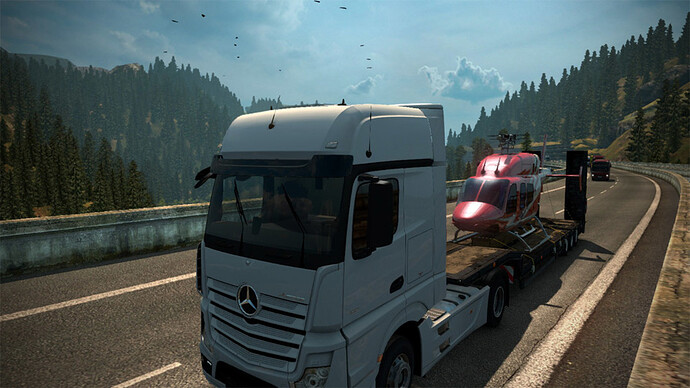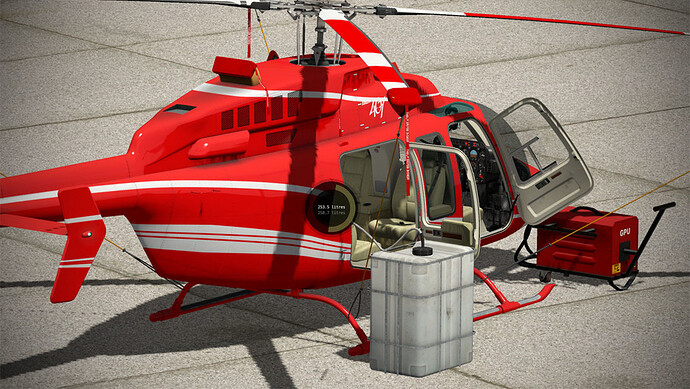With the Beaver delivery complete - I was ready to check out the main reason I had come to Chilliwack. I had been talking to one of my friends in the medevac community a few weeks earlier and he mentioned that their company had suffered a hard landing incident in a landing zone up near Lillooet Hospital. The helo was a Bell 407, and with the rest of the company already standardized on the EC135, they were interested in getting rid of it quickly rather than spending the money to repair the light damage. Thinking I might be able to put the 407 to good use up at my home field of King Ranch in various ways - I decided to take a look-see.
I paid an Uber driver a full day rate to drive me up to Lillooet - it took nearly three hours thanks to some RVs and a portion of road under construction where they were clearing a rockslide. I met with the insurance agent representative, and an airframe and power plant aviation technician (IA) who went over the damage with me. The hard landing was firm enough to warp the skids, but the rest of the aircraft looked to be in very good shape. We batted around some numbers (they were very eager to get it off their books) - and now I’m the owner of a Bell 407! The insurance agent recommended a good local hauler that could get my helo back down to Chilliwack and by late afternoon we were loaded up and heading back down twisty BC-12S.
Beautiful Seton Lake…(uh…yeah)…
The road was pretty twisty…but the views were spectacular…it almost reminded me of Geneva…
In typical Pacific Northwest fashion…the weather soon closed in, making the roads a wet mess in the dim afternoon light…
The driver took a wrong turn at one point and I thought we might come across some zombies or an axe murderer on this stretch…
We pulled off in a truck stop and caught some sleep since we had both had a long day…at first light we resumed the slow grind down the mountains…
By mid morning, we were pulling in to Chilliwack and ready to turn the bird over to Upper Valley Aviation for some much needed TLC…
Within 48 hours - UVA had scrounged up some replacement parts, performed a full inspection, and checked out the rotor tracking using some sophisticated tuning gear. The IA told me that the insurance agent’s IA was way off the mark and nearly everything was within tolerances. He asked me what I had paid for it…when I told him he laughed and said I could probably flip it and pocket a few hundred grand given that he could scrub most of the damage squawks from the logs. I might indeed need to do that at some point, but for now I wanted to check out what this 406 could do. After performing a very, very thorough preflight, I had it fueled to about 50% capacity, and hooked the GPU up for the start.
After removing the tie downs and closing up all the doors and securing all the panels, we are ready to start. I slip the headphones off their holder and instantly the sounds get muffled (neat effect DreamFoil!)…
The first start attempt doesn’t go too well. The MGT gauge spikes, I don’t get a light off, and I have to go into the Helicopter Report health estimate and clear out any previous failures.
The second start attempt the engine spools up normally and rotors slowly start spinning up. The generator goes online and I remove the GPU…
I check things over…then do a hover check in the parking area to make sure all the controls are working properly…
Ready for a short test flight, I plug in Hope Airpark (CYHE) just up the river about 20 miles…
Off we go!
The 406 flies like a dream. I trim it out and we advance toward maximum speed. DreamFoil does a great job of emulating sounds while flying and there is a bit of a muffled whiffing sound as you get up near max speed…
Watch out for the powerlines spanning the Fraser River!
Coming up on Hope Airpark…
This looks like an EPOCH pilot’s kind of place - grass runways and a cozy place to gather…
I set down for a short break, climb out and do a quick walk around inspection to see if anything is amiss. All appears normal…
Heading back to Chilliwack…
I set her down in front of Upper Valley Aviation’s hangar, give the IA a thumbs up, and they push her back into the hangar and get to work. The FBO lets me borrow the crew car for the night and I head into town to see the sights and spend another night.
The next day - the guys at Upper Valley Aviation give me a call - the 406 is done. (Yeah, I know it never happens this quickly…but this is the Virtual World…). I get to the hangar just in time to see them roll it out. There are no words to describe how beautiful DarkAngel1010’s EPOCH repaint looks…fantastic! In addition to the paint, they’ve installed higher clearance skids, skids baskets, and a wire-cutting kit. What a beauty!
I climb all over the helo, checking for left over tape from the painting or any missing panels. They must have run a whole team last night to get it done! The paint shop manager cautions me that the paint isn’t cured yet…so take it easy on it and don’t fly it through any heavy rain…right…like that ever happens in the Pacific Northwest…
I fire it up and head out…
Heli-skiers and rescue victims will see the EPOCH callsign on the bottom…
I plug in the Vancouver heliport and head downriver for the short flight…
Heading across Pitt Meadows on the way…
The Vancouver area doesn’t suffer from ugly scenery…
Soon the downtown area is in view and I set up on the north side toward the helipads…
I settle in near Hudson’s combined helipad and seaplane base…
Now, I could fly the 406 all the way back up to King Ranch…but that would be an almost 1,200 nm journey at 110 knots - even more than this die-hard simmer wants to fly. Thus, I did some poking around down at the intermodal and was put in contact with a guy running the Fairmount Sherpa - an anchor tender that is preparing to depart for Cook Inlet to do some contract work for Shell Oil. They are “dead-heading” up with an empty deck, so I managed to purchase the deck space for them to ferry the 406 up through the Inside Passage.
Coming up on the pier…
Loaded up and ready for the trip. The captain hopes for a two-week transit, but it could be three depending on weather and sea conditions… I’ll see you up in Alaska! Now, I gotta find a ride home!
BeachAV8R















































